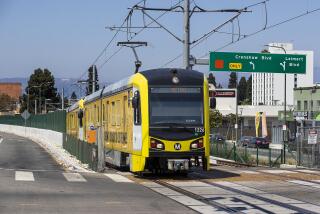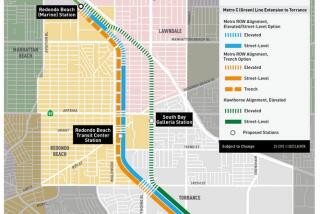Trolley Board Stays on the Track, Sticks With âHookâ
Metropolitan Transit Development Board directors Thursday reaffirmed their plan to operate a non-continuous âhookâ trolley system instead of Chicago-style loops downtown, a decision that will shape the trolleyâs future around the needs of C Street corridor workers and the trolleyâs planned northward expansion.
By rejecting a business groupâs request to run clockwise and counterclockwise loops when the planned Bayside Line opens in 1989, the directors tacitly approved the idea that all parts of downtown do not merit the same trolley service.
âAll parts of Center City are not equal and have different kinds of needs and demands,â said William Lieberman, the MTDBâs director of planning and operations. âThe loop plan serves them all with equal kinds of service. Our plan tries to prioritize.â
The directors adopted the hook configuration Feb. 26, but agreed Aug. 27 to a request by San Diegans Inc., which represents downtown business interests, for further examination of the two plans.
East Line Route
Under the hook plan, the East Line will enter downtown at Commercial and 12th avenues, run north on 12th and west on C Street, then turn south at a new station on the site of the former Tower Bowl at Kettner Boulevard and Broadway. After becoming the new Bayside Line, it will run past Seaport Village, the convention center (now under construction) and along L Street before ending at a station at Imperial and 12th avenues.
But instead of continuing around in a loop, the trolley would then retrace its path.
The South Line comes from San Ysidro, heads north along 12th, west on C Street, and would turn north again along Santa Fe railroad tracks to serve the County Administration Center and a planned northward extension to Old Town and, eventually, beyond.
But Roy Potter, vice president of San Diegans Inc., pressed the directors to run clockwise and counterclockwise circles through downtown, saying that the plan would cost less and prevent rush-hour delays on north-south streets intersecting with C Street.
Conceding that the loop would save the MTDB about $400,000 annually in the next few years because it would make fewer runs, Lieberman told the directors that a study of the issue conducted over the last two weeks shows that the hook has many more advantages. Among his reasons were:
- The C Street corridor contains 51% of Center City jobs, contrasted with just 4% for the bayside corridor. That ratio is expected to continue at least until 2005. While the hook provides more frequent service to the C Street area, the loop provides equal service to both zones and would add five to eight minutes to trips from the South Line to C Street.
- The loop provides no service to the County Administration Center, where a severe parking crunch already exists. The hook plan includes a South Line stop there in 1989, which will later be connected to the Old Town line. Potter argued that few county workers use the trolley now and service to the building could be delayed a few years.
- Trolleys running along C Street do not back up traffic now and will not when the new plan opens in 1989. Lieberman presented time-lapse photography of north-south routes during rush hour showing little congestion at C Street. Potter called the film âsubjective.â
- When planned suburban routes are built during the 1990s, the loop plan would be more expensive to operate than the hook. âIt appears that it has a short-term savings but a long-term cost,â Lieberman said.
Chagrined by the unanimous vote, Potter said after the meeting that âin our opinion, the hook arrangement does not provide appropriate service to the $128-million Convention Center, the $250 million in hotels there and the probably $1 billion more in hotels that will be there.â But Lieberman noted that the number of trains running on the Bayside Line would be identical under either plan.
The MTDB did agree to study a change that San Diegans Inc. called its top priority--adding track at the junction of the Bayside and South lines that would allow the trolley to head either north or south. Under current plans, which are less expensive, the trolley would be forced to turn south at 12th Avenue and L Street and head to the stop at 12th and Imperial avenues.
Trolley planners will also study the possibility of hooking the South Line instead of the East Line, a plan that appears to be slightly more efficient than the current strategy, Lieberman said.
More to Read
Sign up for Essential California
The most important California stories and recommendations in your inbox every morning.
You may occasionally receive promotional content from the Los Angeles Times.










